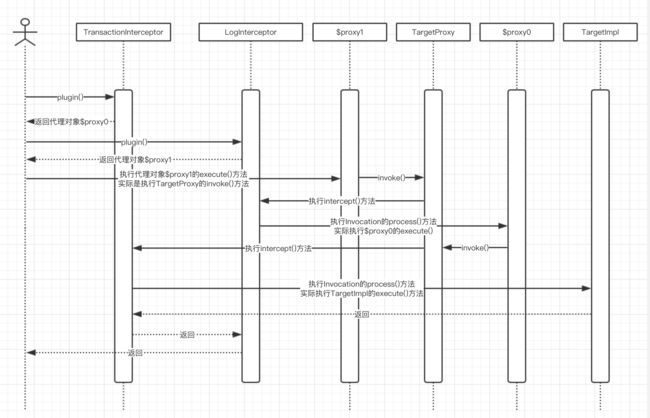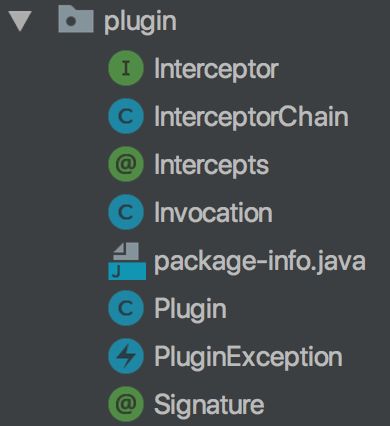Mybatis Plugin 插件(拦截器)原理分析
引言
最近在看mybatis 源码,看到了mybatis plugin部分,其实就是利用JDK动态代理和责任链设计模式的综合运用。采用责任链模式,通过动态代理组织多个拦截器,通过这些拦截器你可以做一些你想做的事。具体分析从一个普通的需求功能开始:现在要对所有的接口方法做一个日志记录和接口耗时记录。
需求分析和功能实现
看到这个需求功能我默默的笑了,这还不简单,每个方法我都加上不就行了吗?就这么干,撸起袖子开始噼噼啪啪的敲打着键盘,慢慢发现太特么多方法了,而且还是基本重复的,这样写下去不是办法啊。这么多重复的是不是可以抽取出来呢,要坚持 DRY(Don't repeat yourself)原则。这时候想到了代理设计模式,静态代理模式肯定不行,这么多接口,得写多少个代理类啊,还是用JDK的动态代理吧
JDK动态代理
public interface Target {
String execute(String name);
}
public class TargetImpl implements Target {
@Override
public String execute(String name) {
System.out.println("execute() "+ name);
return name;
}
}
public class TargetProxy implements InvocationHandler {
private Object target;
public TargetProxy(Object target) {
this.target = target;
}
@Override
public Object invoke(Object proxy, Method method, Object[] args) throws Throwable {
System.out.println(" 拦截前。。。");
Object result = method.invoke(target, args);
System.out.println(" 拦截后。。。");
return result;
}
public static Object wrap(Object target) {
return Proxy.newProxyInstance(target.getClass().getClassLoader(),
target.getClass().getInterfaces(),new TargetProxy(target));
}
}
public class Test {
public static void main(String[] args) {
Target target = new TargetImpl();
//返回的是代理对象,实现了Target接口,
//实际调用方法的时候,是调用TargetProxy的invoke()方法
Target targetProxy = (Target) TargetProxy.wrap(target);
targetProxy.execute(" HelloWord ");
}
}
TargetProxy.wrap(target) 实际返回的对象类似下面这样,这样看起来就容易理解点了
public class $Proxy implements Target {
private InvocationHandler targetProxy
@Override
public String execute(String name) {
return targetProxy.invoke();
}
}
运行结果:
拦截前。。。
execute() HelloWord
拦截后。。。
嗯,这思路是正确的了。但还是存在问题,execute() 是业务代码,我把所有的要拦截处理的逻辑都写到invoke方法里面了,不符合面向对象的思想,可以抽象一下处理。可以设计一个Interceptor接口,需要做什么拦截处理实现接口就行了。
public interface Interceptor {
/**
* 具体拦截处理
*/
void intercept();
}
intercept() 方法就可以处理各种前期准备了
public class LogInterceptor implements Interceptor {
@Override
public void intercept() {
System.out.println(" 记录日志 ");
}
}
public class TransactionInterceptor implements Interceptor {
@Override
public void intercept() {
System.out.println(" 开启事务 ");
}
}
代理对象也做一下修改
public class TargetProxy implements InvocationHandler {
private Object target;
private List interceptorList = new ArrayList<>();
public TargetProxy(Object target,List interceptorList) {
this.target = target;
this.interceptorList = interceptorList;
}
@Override
public Object invoke(Object proxy, Method method, Object[] args) throws Throwable {
/**
* 处理拦截
*/
for (Interceptor interceptor : interceptorList) {
interceptor.intercept();
}
return method.invoke(target, args);
}
public static Object wrap(Object target,List interceptorList) {
TargetProxy targetProxy = new TargetProxy(target, interceptorList);
return Proxy.newProxyInstance(target.getClass().getClassLoader(),
target.getClass().getInterfaces(),targetProxy);
}
}
现在可以根据需要动态的添加拦截器了,在每次执行业务代码execute(...)之前都会拦截,看起来高级一丢丢了,来测试一下
public class Test {
public static void main(String[] args) {
List interceptorList = new ArrayList<>();
interceptorList.add(new LogInterceptor());
interceptorList.add(new TransactionInterceptor());
Target target = new TargetImpl();
Target targetProxy = (Target) TargetProxy.wrap(target,interceptorList);
targetProxy.execute(" HelloWord ");
}
}
执行结果:
记录日志
开启事务
execute() HelloWord
貌似有哪里不太对一样,按照上面这种我们只能做前置拦截,而且拦截器并不知道拦截对象的信息。应该做更一步的抽象,把拦截对象信息进行封装,作为拦截器拦截方法的参数,把拦截目标对象真正的执行方法放到Interceptor中完成,这样就可以实现前后拦截,并且还能对拦截对象的参数等做修改。设计一个Invocation 对象
public class Invocation {
/**
* 目标对象
*/
private Object target;
/**
* 执行的方法
*/
private Method method;
/**
* 方法的参数
*/
private Object[] args;
//省略getset
public Invocation(Object target, Method method, Object[] args) {
this.target = target;
this.method = method;
this.args = args;
}
/**
* 执行目标对象的方法
* @return
* @throws Exception
*/
public Object process() throws Exception{
return method.invoke(target,args);
}
}
拦截接口做修改
public interface Interceptor {
/**
* 具体拦截处理
* @param invocation
* @return
* @throws Exception
*/
Object intercept(Invocation invocation) throws Exception;
}
Invocation 类就是被代理对象的封装,也就是要拦截的真正对象。TargetProxy修改如下:
public class TargetProxy implements InvocationHandler {
private Object target;
private Interceptor interceptor;
public TargetProxy(Object target,Interceptor interceptor) {
this.target = target;
this.interceptor = interceptor;
}
@Override
public Object invoke(Object proxy, Method method, Object[] args) throws Throwable {
Invocation invocation = new Invocation(target,method,args);
return interceptor.intercept(invocation);
}
public static Object wrap(Object target,Interceptor interceptor) {
TargetProxy targetProxy = new TargetProxy(target, interceptor);
return Proxy.newProxyInstance(target.getClass().getClassLoader(),target.getClass().getInterfaces(),targetProxy);
}
}
public class TransactionInterceptor implements Interceptor {
@Override
public Object intercept(Invocation invocation) throws Exception{
System.out.println(" 开启事务 ");
Object result = invocation.process();
System.out.println(" 提交事务 ");
return result;
}
}
public class Test {
public static void main(String[] args) {
Target target = new TargetImpl();
Interceptor transactionInterceptor = new TransactionInterceptor();
Target targetProxy = (Target) TargetProxy.wrap(target,transactionInterceptor);
targetProxy.execute(" HelloWord ");
}
}
运行结果:
开启事务
execute() HelloWord
提交事务
这样就能实现前后拦截,并且拦截器能获取拦截对象信息,这样扩展性就好很多了。但是测试例子的这样调用看着很别扭,对应目标类来说,只需要了解对他插入了什么拦截就好。再修改一下,在拦截器增加一个插入目标类的方法
public interface Interceptor {
/**
* 具体拦截处理
* @param invocation
* @return
* @throws Exception
*/
Object intercept(Invocation invocation) throws Exception;
/**
* 插入目标类
* @param target
* @return
*/
Object plugin(Object target);
}
public class TransactionInterceptor implements Interceptor {
@Override
public Object intercept(Invocation invocation) throws Exception{
System.out.println(" 开启事务 ");
Object result = invocation.process();
System.out.println(" 提交事务 ");
return result;
}
@Override
public Object plugin(Object target) {
return TargetProxy.wrap(target,this);
}
}
这样目标类仅仅需要在执行前,插入需要的拦截器就好了,测试代码:
public class Test {
public static void main(String[] args) {
Target target = new TargetImpl();
Interceptor transactionInterceptor = new TransactionInterceptor();
//把事务拦截器插入到目标类中
target = (Target) transactionInterceptor.plugin(target);
target.execute(" HelloWord ");
}
}
运行结果:
开启事务
execute() HelloWord
提交事务
到这里就差不多完成了,可能有同学可能会有疑问,那我要添加多个拦截器呢,怎么搞?
public class Test {
public static void main(String[] args) {
Target target = new TargetImpl();
Interceptor transactionInterceptor = new TransactionInterceptor();
target = (Target) transactionInterceptor.plugin(target);
LogInterceptor logInterceptor = new LogInterceptor();
target = (Target)logInterceptor.plugin(target);
target.execute(" HelloWord ");
}
}
运行结果:
开始记录日志
开启事务
execute() HelloWord
提交事务
结束记录日志
其实这就是代理嵌套再代理,下图是执行的时序图,每个步骤就不做详细的说明了
责任链
其实上面已经实现的没问题了,只是还差那么一点点,添加多个拦截器的时候不太美观,让我们再次利用面向对象思想封装一下。我们设计一个InterceptorChain 拦截器链类
public class InterceptorChain {
private List interceptorList = new ArrayList<>();
/**
* 插入所有拦截器
* @param target
* @return
*/
public Object pluginAll(Object target) {
for (Interceptor interceptor : interceptorList) {
target = interceptor.plugin(target);
}
return target;
}
public void addInterceptor(Interceptor interceptor) {
interceptorList.add(interceptor);
}
/**
* 返回一个不可修改集合,只能通过addInterceptor方法添加
* 这样控制权就在自己手里
* @return
*/
public List getInterceptorList() {
return Collections.unmodifiableList(interceptorList);
}
}
其实就是通过pluginAll() 方法包一层把所有的拦截器插入到目标类去而已。测试代码:
public class Test {
public static void main(String[] args) {
Target target = new TargetImpl();
Interceptor transactionInterceptor = new TransactionInterceptor();
LogInterceptor logInterceptor = new LogInterceptor();
InterceptorChain interceptorChain = new InterceptorChain();
interceptorChain.addInterceptor(transactionInterceptor);
interceptorChain.addInterceptor(logInterceptor);
target = (Target) interceptorChain.pluginAll(target);
target.execute(" HelloWord ");
}
}
Mybatis Plugin 插件分析
经过上面的分析,再去看mybastis plugin 源码的时候就很轻松了。
有没有觉得似曾相似的感觉呢,没错你的感觉是对的,这基本和我们上面的最终实现是一致的,Plugin 相当于我们的TargetProxy。
Mybatis Plugin 介绍及配置使用
MyBatis 允许你在已映射语句执行过程中的某一点进行拦截调用。默认情况下,MyBatis允许使用插件来拦截的方法调用包括:
1.Executor (update, query, flushStatements, commit, rollback, getTransaction, close, isClosed) 拦截执行器的方法;
2.ParameterHandler (getParameterObject, setParameters) 拦截参数的处理;
3.ResultSetHandler (handleResultSets, handleOutputParameters) 拦截结果集的处理;
4.StatementHandler (prepare, parameterize, batch, update, query) 拦截Sql语法构建的处理
参考Mybatis 官方的一个例子:
-
在全局配置文件mybatis-config.xml 添加
-
写好拦截类代码
@Intercepts({@Signature(type= Executor.class, method = "update", args = {MappedStatement.class,Object.class})}) public class ExamplePlugin implements Interceptor { public Object intercept(Invocation invocation) throws Throwable { return invocation.proceed(); } public Object plugin(Object target) { return Plugin.wrap(target, this); } public void setProperties(Properties properties) { } }这个拦截器会拦截Executor接口的update方法
源码简要分析
首先从配置文件解析开始
public class XMLConfigBuilder extends BaseBuilder {
//解析配置
private void parseConfiguration(XNode root) {
try {
//省略部分代码
pluginElement(root.evalNode("plugins"));
} catch (Exception e) {
throw new BuilderException("Error parsing SQL Mapper Configuration. Cause: " + e, e);
}
}
private void pluginElement(XNode parent) throws Exception {
if (parent != null) {
for (XNode child : parent.getChildren()) {
String interceptor = child.getStringAttribute("interceptor");
Properties properties = child.getChildrenAsProperties();
Interceptor interceptorInstance = (Interceptor) resolveClass(interceptor).newInstance();
interceptorInstance.setProperties(properties);
//调用InterceptorChain.addInterceptor
configuration.addInterceptor(interceptorInstance);
}
}
}
}
上面的代码主要是解析配置文件的plugin节点,根据配置的interceptor 属性实例化Interceptor 对象,然后添加到Configuration 对象中的InterceptorChain 属性中
public class InterceptorChain {
private final List interceptors = new ArrayList();
public Object pluginAll(Object target) {
//循环调用每个Interceptor.plugin方法
for (Interceptor interceptor : interceptors) {
target = interceptor.plugin(target);
}
return target;
}
public void addInterceptor(Interceptor interceptor) {
interceptors.add(interceptor);
}
public List getInterceptors() {
return Collections.unmodifiableList(interceptors);
}
}
这个就和我们上面实现的是一样的。定义了拦截器链,初始化配置文件的时候就把所有的拦截器添加到拦截器链中,下面来看一下什么时候把拦截器插入到需要拦截的接口中
public class Configuration {
protected final InterceptorChain interceptorChain = new InterceptorChain();
//创建参数处理器
public ParameterHandler newParameterHandler(MappedStatement mappedStatement, Object parameterObject, BoundSql boundSql) {
//创建ParameterHandler
ParameterHandler parameterHandler = mappedStatement.getLang().createParameterHandler(mappedStatement, parameterObject, boundSql);
//插件在这里插入
parameterHandler = (ParameterHandler) interceptorChain.pluginAll(parameterHandler);
return parameterHandler;
}
//创建结果集处理器
public ResultSetHandler newResultSetHandler(Executor executor, MappedStatement mappedStatement, RowBounds rowBounds, ParameterHandler parameterHandler,
ResultHandler resultHandler, BoundSql boundSql) {
//创建DefaultResultSetHandler
ResultSetHandler resultSetHandler = new DefaultResultSetHandler(executor, mappedStatement, parameterHandler, resultHandler, boundSql, rowBounds);
//插件在这里插入
resultSetHandler = (ResultSetHandler) interceptorChain.pluginAll(resultSetHandler);
return resultSetHandler;
}
//创建语句处理器
public StatementHandler newStatementHandler(Executor executor, MappedStatement mappedStatement, Object parameterObject, RowBounds rowBounds, ResultHandler resultHandler, BoundSql boundSql) {
//创建路由选择语句处理器
StatementHandler statementHandler = new RoutingStatementHandler(executor, mappedStatement, parameterObject, rowBounds, resultHandler, boundSql);
//插件在这里插入
statementHandler = (StatementHandler) interceptorChain.pluginAll(statementHandler);
return statementHandler;
}
public Executor newExecutor(Transaction transaction) {
return newExecutor(transaction, defaultExecutorType);
}
//产生执行器
public Executor newExecutor(Transaction transaction, ExecutorType executorType) {
executorType = executorType == null ? defaultExecutorType : executorType;
//这句再做一下保护,囧,防止粗心大意的人将defaultExecutorType设成null?
executorType = executorType == null ? ExecutorType.SIMPLE : executorType;
Executor executor;
//然后就是简单的3个分支,产生3种执行器BatchExecutor/ReuseExecutor/SimpleExecutor
if (ExecutorType.BATCH == executorType) {
executor = new BatchExecutor(this, transaction);
} else if (ExecutorType.REUSE == executorType) {
executor = new ReuseExecutor(this, transaction);
} else {
executor = new SimpleExecutor(this, transaction);
}
//如果要求缓存,生成另一种CachingExecutor(默认就是有缓存),装饰者模式,所以默认都是返回CachingExecutor
if (cacheEnabled) {
executor = new CachingExecutor(executor);
}
//此处调用插件,通过插件可以改变Executor行为
executor = (Executor) interceptorChain.pluginAll(executor);
return executor;
}
}
从代码可以看出mybatis 在实例化Executor、ParameterHandler、ResultSetHandler、StatementHandler四大接口对象的时候调用interceptorChain.pluginAll() 方法插入进去的。其实就是循环执行拦截器链所有的拦截器的plugin() 方法,mybatis官方推荐的plugin方法是Plugin.wrap() 方法,这个类就是我们上面的TargetProxy类
public class Plugin implements InvocationHandler {
public static Object wrap(Object target, Interceptor interceptor) {
//从拦截器的注解中获取拦截的类名和方法信息
Map, Set> signatureMap = getSignatureMap(interceptor);
//取得要改变行为的类(ParameterHandler|ResultSetHandler|StatementHandler|Executor)
Class type = target.getClass();
//取得接口
Class[] interfaces = getAllInterfaces(type, signatureMap);
//产生代理,是Interceptor注解的接口的实现类才会产生代理
if (interfaces.length > 0) {
return Proxy.newProxyInstance(
type.getClassLoader(),
interfaces,
new Plugin(target, interceptor, signatureMap));
}
return target;
}
@Override
public Object invoke(Object proxy, Method method, Object[] args) throws Throwable {
try {
//获取需要拦截的方法
Set methods = signatureMap.get(method.getDeclaringClass());
//是Interceptor实现类注解的方法才会拦截处理
if (methods != null && methods.contains(method)) {
//调用Interceptor.intercept,也即插入了我们自己的逻辑
return interceptor.intercept(new Invocation(target, method, args));
}
//最后还是执行原来逻辑
return method.invoke(target, args);
} catch (Exception e) {
throw ExceptionUtil.unwrapThrowable(e);
}
}
//取得签名Map,就是获取Interceptor实现类上面的注解,要拦截的是那个类(Executor,ParameterHandler, ResultSetHandler,StatementHandler)的那个方法
private static Map, Set> getSignatureMap(Interceptor interceptor) {
//取Intercepts注解,例子可参见ExamplePlugin.java
Intercepts interceptsAnnotation = interceptor.getClass().getAnnotation(Intercepts.class);
// issue #251
//必须得有Intercepts注解,没有报错
if (interceptsAnnotation == null) {
throw new PluginException("No @Intercepts annotation was found in interceptor " + interceptor.getClass().getName());
}
//value是数组型,Signature的数组
Signature[] sigs = interceptsAnnotation.value();
//每个class里有多个Method需要被拦截,所以这么定义
Map, Set> signatureMap = new HashMap, Set>();
for (Signature sig : sigs) {
Set methods = signatureMap.get(sig.type());
if (methods == null) {
methods = new HashSet();
signatureMap.put(sig.type(), methods);
}
try {
Method method = sig.type().getMethod(sig.method(), sig.args());
methods.add(method);
} catch (NoSuchMethodException e) {
throw new PluginException("Could not find method on " + sig.type() + " named " + sig.method() + ". Cause: " + e, e);
}
}
return signatureMap;
}
//取得接口
private static Class[] getAllInterfaces(Class type, Map, Set> signatureMap) {
Set> interfaces = new HashSet>();
while (type != null) {
for (Class c : type.getInterfaces()) {
//拦截其他的无效
if (signatureMap.containsKey(c)) {
interfaces.add(c);
}
}
type = type.getSuperclass();
}
return interfaces.toArray(new Class[interfaces.size()]);
}
}
总结
Mybatis 拦截器的使用是实现Interceptor接口
public interface Interceptor {
//拦截
Object intercept(Invocation invocation) throws Throwable;
//插入
Object plugin(Object target);
//设置属性(扩展)
void setProperties(Properties properties);
}
通过上面的分析可以知道,所有可能被拦截的处理类都会生成一个代理类,如果有N个拦截器,就会有N个代理,层层生成动态代理是比较耗性能的。而且虽然能指定插件拦截的位置,但这个是在执行方法时利用反射动态判断的,初始化的时候就是简单的把拦截器插入到了所有可以拦截的地方。所以尽量不要编写不必要的拦截器。

